Medical Cable Assemblies: Overmolded and Assembled
Read time: 4 minutes
Intro:
Overmolded or assembled cables? When choosing the best approach for medical cable assemblies, both may be practical options to use depending on the application.
Examples of what overmolded and assembled cables are:
- Connector Bend Reliefs: Slip on boots vs. overmolding bend protections (strain reliefs) onto cables and connectors
- Transition yokes vs. assembled clamshells
This month’s ClearPath Medical blog will provide a brief overview on both overmolded and assembled cables and their capabilities.
Overmolding
To begin, overmolding is a multi-step process that has two or more components molded over the top of another. During the process of overmolding, molten materials, such as thermoplastics or silicone, are injected into a mold cavity over the cable and connector or components to encapsulate the two parts into one. Check out our blog: Fundamentals of Overmolding for more information.
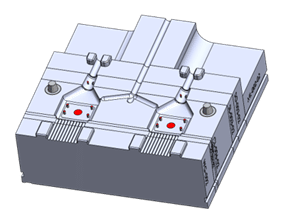

Figures 1 & 2: Mold Cavities
Overmolding Capabilities
Additionally, overmolding capabilities increases functionality, and its process alters from traditional cable assembly. For instance, it enhances the cable assemblies that rely on back-shells or heat shrink.
Here’s a list of reasons why a customer will choose to overmold their cable assemblies:
Customization- Overmolded cable assemblies are an option for customization seekers. Customers may select any color, shape, or texture they desire for their cable. To enhance the mechanical properties, overmolded assemblies have capabilities to enhance for flexibility, tensile performance, temperature variances, water and dust ingress protection and more.
Other reasons why customers will choose overmolded cables:
- Brand matching with their company
- Seamless cable blending and professional finishes
- Visual differentiation
Quality- When it comes to overmolded cables, the overall molding process allows fewer installation errors. For this reason, the shelf life of the cables may be extended. These cables may withstand high temperatures or deal with rigorous usage. In this case, it’s important that the cables are durable and will protect against foreign objects, water, or dust. A rule of thumb to ensure the durability is that it meets or exceeds ANSI AAMI EC53, IEC 60601 requirements and “IP” (Ingress Protection) codes. Read more about Ingress Protection in our blog here.
Cost- Overmolded cables may be cost-effective due to less materials used and lower labor costs. Overmolding replaces the usual plastic or metal back-shells, strain, and bend reliefs by using much less material and extra labor. Conversely, non-recurring expenses for custom tooling may be required.
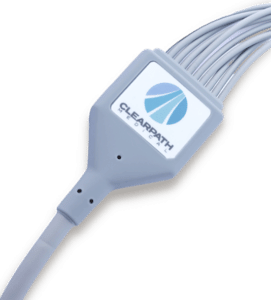
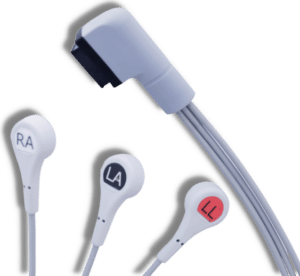
Figures 3 & 4: Standard overmolded yoke and 3-lead ECG cable.
Friendly Tip: In order to ensure all cable specs are met and to reduce manufacturing mistakes, plan and meet with the supplier at the earliest convenience.
Assembled Cables
Assembled cables, as the name suggests, means cables that have several pieces that are assembled together. To explain, there is a pre-formed, standard shell, usually made of metal or plastic material for assembled cables. For most designs, assembled cables will do what is needed and depending on its application, it could be the only option.
Assembled Capabilities
As an example, assembled cables may utilize pre-manufactured bend protections (strain reliefs). Connector companies may offer a list of available bend protections for customers to pick and choose based on color and cable diameter ranges. Another example of assembled cables are pre-molded clamshells.
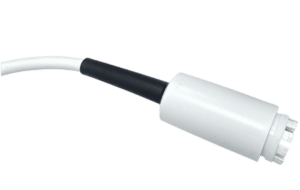
Figure 4: Black slip on boot

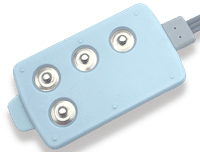
Figure 5: Front and back assembled clamshell
Installation- Experience and knowledge from technicians is an important factor for cable assembly, since much of it happens in-house. A team with a proper training and experience for medical cable assembly will prevent failed cables and incorrect installation.
Cost- Assembled cables are known to be less expensive to produce. Typically, assembled cables is preferable for low-volume productions. However, it’s important to keep in mind the labor costs of the installation and a higher potential of installation errors, which will may add to the overall expense.
Quality & Repair- Due to assembled cables having multiple components and quick assembly, in some instances, it may be disassembled for repairs or replacements. Generally, assembled cables have a shorter life span due to materials uses. However, it’s important for specific applications, and assembled cables will work best in an environment where it’s seldom disconnected or reattached.
Wrapping Things Up
Overall, knowing and understanding the process to build overmolded and assembled cables is an important role when deciding which path to choose. ClearPath Medical has many years of experience in designing, developing and manufacturing both overmolded and assembled medical cables. We are eager to help you create your next custom cable with us. Contact us to learn more and get started with your next cable assembly and learn more about our capabilities.
Thanks for reading! Here are some more ClearPath Medical blogs that might interest you.
Love what you see? Sign up for our newsletter to get the latest updates on our company, worldwide and more. Be sure to also follow us on LinkedIn for company updates, news, and more!

